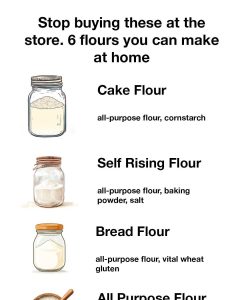In recent years, more and more people have been turning to homemade and artisanal food products to improve the quality of their meals and reduce reliance on store-bought items. One of the most rewarding practices in this movement is making your own flour at home. While it might sound like a complicated process, the truth is that it’s easier than you think—and incredibly satisfying. With just a few simple tools and ingredients, you can create high-quality flour tailored to your dietary needs and cooking preferences. This guide will walk you through six types of flour you can easily make at home. Not only will this save you frequent trips to the store, but it will also guarantee you’re using the freshest, cleanest flour possible.

There are several clear advantages to making flour yourself. For starters, you control the source and quality of the ingredients, meaning your flour is free from unwanted additives, preservatives, or processing agents. This is especially valuable if you’re on a specialized diet, such as gluten-free, low-carb, or whole grain. Making flour at home can also be more economical in the long run, particularly when you buy grains or seeds in bulk. Beyond the practical benefits, there’s something personally fulfilling about grinding your own flour. It connects you to your food in a way that many modern conveniences can’t, and it deepens your understanding of the ingredients that form the foundation of your cooking and baking.
To get started with homemade flour, you’ll need a few essential tools. A reliable grain mill or a high-powered blender is necessary to grind grains into fine flour. Depending on the type of flour you want to make, you’ll also need various grains or seeds such as wheat berries, rice, almonds, or potatoes. A fine mesh sieve or sifter is helpful for refining the flour’s texture. And don’t forget storage—airtight containers will keep your homemade flour fresh and free from moisture or pests.
One of the easiest and most useful flours to make at home is cake flour. Known for its soft, airy texture and low protein content, cake flour helps produce light, tender cakes. To make it, measure one cup of all-purpose flour and remove two tablespoons. Replace those two tablespoons with cornstarch. Sift the mixture two to three times to ensure the cornstarch is well incorporated and the flour is aerated. This simple method mimics the performance of store-bought cake flour and is perfect for recipes that require a delicate crumb.
Another staple you can make at home is self-rising flour, which already contains leavening agents. This type of flour is a go-to for quick breads, pancakes, and biscuits. To prepare it, mix one cup of all-purpose flour with one and a half teaspoons of baking powder and a quarter teaspoon of salt. Stir or whisk until everything is evenly combined. Store the blend in an airtight container, clearly labeled to avoid confusing it with plain flour. This handy mix saves time and ensures consistent baking results.
Bread flour, on the other hand, is essential for recipes requiring extra structure, such as pizza dough, sandwich loaves, or rustic artisan bread. Its higher protein content helps develop gluten, which provides that chewy, elastic texture. To make your own bread flour, combine one cup of all-purpose flour with one tablespoon of vital wheat gluten. Whisk thoroughly to ensure even distribution. Vital wheat gluten is readily available in most grocery stores, usually in the baking or health food section.
If you’re avoiding gluten, you can still make a versatile and reliable flour blend at home. A good gluten-free mix includes two cups of rice flour, two-thirds of a cup of potato starch, and one-third of a cup of tapioca flour. Blend them thoroughly and store in an airtight container in a cool, dry place. This mix can replace all-purpose flour at a 1:1 ratio in most recipes. For best results, especially in baked goods, consider adding a binding agent like xanthan gum—about half a teaspoon per cup of flour—to mimic the texture that gluten provides.
You might also be interested in making your own all-purpose flour. Start with whole wheat berries, which you can grind using a grain mill or high-powered blender. Once ground, sift the flour through a fine mesh sieve to remove the bran and germ, which results in a lighter, more versatile flour. Repeat the sifting process until you reach the texture you want. Though it’s slightly less refined than store-bought versions, homemade all-purpose flour works well in everything from sauces to baked goods.
Whole wheat flour, by contrast, keeps all parts of the wheat berry—bran, germ, and endosperm—making it a healthier and more nutrient-rich option. To make it, grind whole wheat berries without sifting. This retains the fiber and vitamins naturally found in the wheat. Because the natural oils in the germ can spoil over time, it’s best to store whole wheat flour in the refrigerator or freezer to maintain freshness.
Proper storage plays a huge role in maintaining the quality of your homemade flours. Always use airtight containers and store them in a cool, dark place such as a pantry or kitchen cabinet. If you live in a humid climate or want to extend shelf life, refrigerate or freeze your flours—particularly those that contain the germ, like whole wheat or nut-based flours. Be sure to label each container with the type of flour and the date it was made. This helps you rotate through your supply efficiently and ensures you always use the freshest batch.
In conclusion, making flour at home is an enriching practice that goes beyond just saving money or avoiding additives. It allows you to customize your ingredients to suit your personal health goals and cooking styles. Whether you’re baking a rustic sourdough loaf or whipping up a delicate sponge cake, homemade flour offers superior freshness and flavor. With just a few tools and some curiosity, you can bring a deeper sense of craftsmanship and satisfaction to your kitchen.





